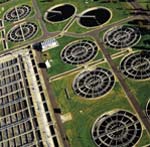The grants will be used to demonstrate innovative integrated pest management practices, technologies, outreach and education.

The Denver Water director of finance will take the reins on May 3.
The Nuclear Regulatory Commission is considering a rulemaking for the disposal of tritium exit signs, which contain a radioactive form of hydrogen.
A December 2009 inspection of Desloge Mine Tailings Site revealed that the company had not reduced pathogens nor minimized vector attraction.
The agency says the project would bury more than 7 miles of headwater streams, impact 2,278 acres of forestland, and degrade stream water quality
EPA expects the move will help clean up air quality for U.S. ports as well as inland population centers.
The Global EcoEasy Challenge selects seven finalist concepts from universities in five countries.
Warming conditions shift a coral's predominantly beneficial bacteria to pathogens, according to Cornell researchers who developed the mathematical models.
The top energy entry replaced the top layer of solar cells with a thinner polysilicon at lower temperatures.
The New York City petition would have restricted use and increased cost, according to the Consumer Specialty Products Association trade group.
Dairy cow manure is broken down to create methane biogas, which is burned to produce electricity and sent to the power grid.
EPA Region 7 issues compliance order and notice of noncompliance related to a 2005-2006 prison dormitory renovation project in Topeka.
Florida residents will have three more chances to air their comments starting April 13 at Fort Myers.
Submissions for the Water Environment Research Foundation's Paul L. Busch Award must be submitted by June 1.
Health and Environmental Research Online provides access to scientific studies used in making key regulatory decisions.

Ozone and biological media filtration coupled with UV and chlorine disinfection are the preferred treatment processes.
The American Water Works Association will present information on "Water Resource Strategies for Climate Change and Shortages" and "Disinfection Byproducts: Recent Research Raises Concerns."
Plant diversity and composition weigh heavily in determining potential energy yield per acre from biomass harvested from Conservation Reserve Program land.
Selectively burning underbrush and small trees can lower the chances of high severity wildfires that affect large trees and release more carbon dioxide, according to Christine Wiedinmyer with the National Center for Atmospheric Research.